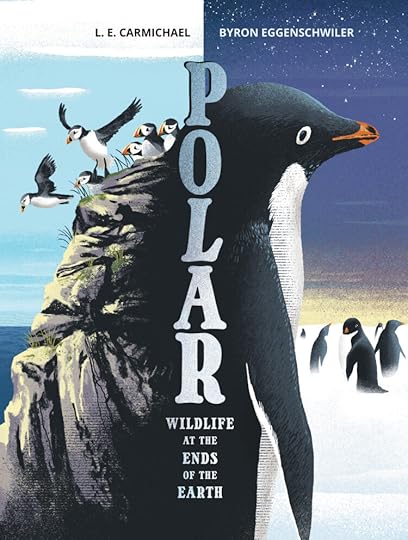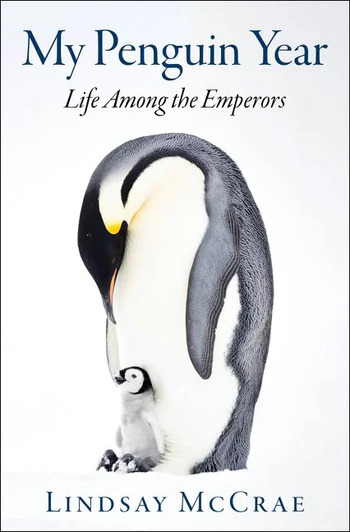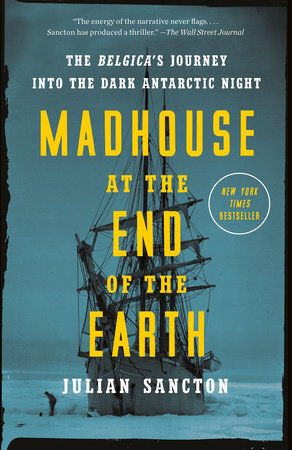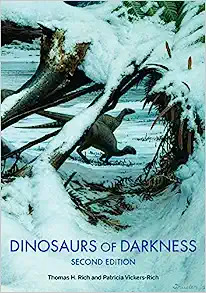L.E. Carmichael's Blog, page 6
January 5, 2024
Aimee Reid: The Birth of a Book
 Welcome to Cantastic Authorpalooza, featuring posts by and about great Canadian children’s book creators! Today’s guest:
Aimee Reid
. Take it away, Aimee!
Welcome to Cantastic Authorpalooza, featuring posts by and about great Canadian children’s book creators! Today’s guest:
Aimee Reid
. Take it away, Aimee!
I remember the months of waiting for my first child to be born as both a thrilling and vulnerable time.
As is my tendency when encountering change, I prepared and planned as much as I could. I followed developmental milestones with The Pregnancy Journal, and made note of my experiences. My shakiness and exhaustion were made somewhat easier to bear because I knew how my body was growing the baby inside me.
My friend loaned me books on early childhood. I filled the freezer with package after package of prepared meals until my husband gently informed me that we simply had no more room.
One morning, five weeks before my due date, my husband found me in the nursery at 5:30 a.m., attempting to stretch sheets over the crib mattress so that everything would be ready in case the baby came early. He gently ushered me back to bed. I had done all I could, and now I just had to wait.
Wait I did. My due date came and went. I tidied and re-tidied and baked and tried to make the time pass. This part of my gestation was a keenly-felt reminder that much about parenting would be out of my hands.
Nine days later, after a longer labour than expected, I finally saw my baby’s face. What an unforgettable moment! Our baby was here, and our family’s journey together had begun.
I have often mused on the similarities between birthing a baby and birthing a book. First glimpsing the illustrations for my picture books is a little like seeing my baby’s face for the first time. As I take my first peek, I feel a swell of tenderness and pride and think, “Oh! It’s you! Hello, you.” The day of a book’s release feels like sending a child off to the first day of school. I take a deep breath and wish my book well, hoping it finds its readers.
I am writing this post on the birthday for my newest picture book, A World of Love. It releases today from Nancy Paulsen Books at Penguin Random House. Joyful and touching illustrations by Chris Lyles bring the emotion of the text to vibrant life.
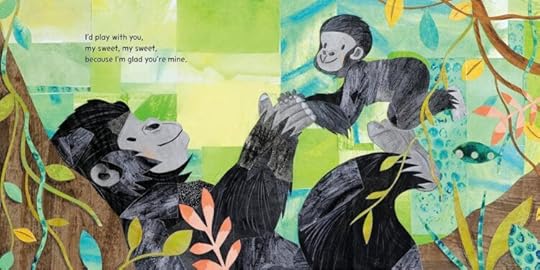
Today I’m recalling the beginning of A World of Love, which came to me in the form of a line that began running through my head: “If all the world were forests green / and you were in the nest . . . .” From that spark, I wrote a lyrical reflection on the many ways that animals care for their young. Doves coo, dolphins call to their babies, and mountain goats shield their kids from falls. The final scene shows a human parent celebrating the enduring nature of love for her child.
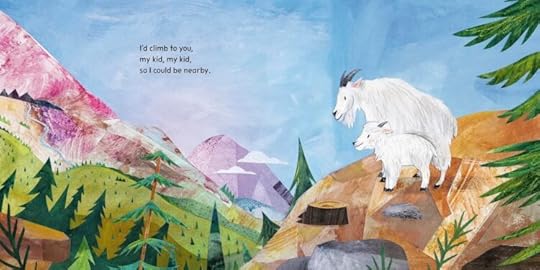
The tenderness and care portrayed in the book is shown day after day the world over. I hope that all who read A World of Love will be reminded of how we are connected. Each loving act matters more than we know.
This book has come a long way from my first jotted notes. Just as a parent needs a community, I’m grateful for everyone who played a part in its journey. We have nurtured it with care and now we release it into the world, hoping that it finds its way to you! May you experience some beauty in your world today.
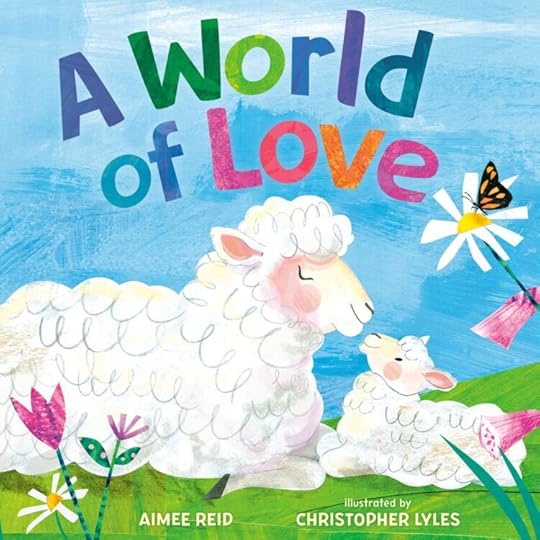 You can find A World of Love here: A World of Love by Aimee Elizabeth Reid: 9781524739812 | PenguinRandomHouse.com: Books
You can find A World of Love here: A World of Love by Aimee Elizabeth Reid: 9781524739812 | PenguinRandomHouse.com: Books
Find Aimee at www.aimeereidbooks.com
Instagram, Threads, X, Facebook: @aimeereidbooks
Visit Chris Lyles at Chris Lyles Designs – Illustrator
Facebook: www.facebook.com/LylesDesigns/
Instagram: @chrislylesdesigns
Pinterest: Christopher Lyles (chrislylesart) – Profile | Pinterest
December 28, 2023
A Dickens Year and a Schrodinger’s Week
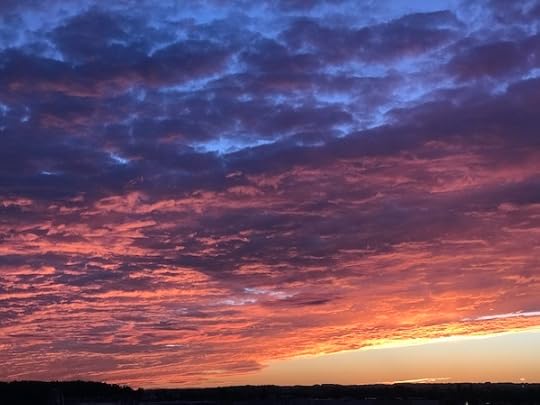 The week between Christmas and New Years’s is always a weird one for me. We’re poised on the brink between last year and next year, reflecting on 2023 and planning for 2024. Caught between leftover holiday indulgences and upcoming new year’s resolutions. Somewhere between the coziness and lights of the holidays and bracing ourselves for the long dark months of winter still to come. We’re all technically working, but no one’s working all that hard.
The week between Christmas and New Years’s is always a weird one for me. We’re poised on the brink between last year and next year, reflecting on 2023 and planning for 2024. Caught between leftover holiday indulgences and upcoming new year’s resolutions. Somewhere between the coziness and lights of the holidays and bracing ourselves for the long dark months of winter still to come. We’re all technically working, but no one’s working all that hard.
It’s a liminal time – caught between one thing and another, both and neither at the same time. Basically, it’s Schrodinger’s week, coming at the end of a Dickens’ year: 2023 has been both the best of times and the worst of times.
Under the best of times column, I launched a book I’m incredibly proud of, and other people seem to like it too — Polar is a Eureka! Honour Book and an Orbis Pictus Recommended Book now. Tech Support and I had an unusually high number of travel adventures. And I did quite a few things (climbing mountains, riding bikes, crying in front of other people without feeling uncomfortable about it) that I had no idea I was capable of.
But then there are the worst of times. The Carmichaels have experienced two family health crises this year, both of which will continue into 2024. Several manuscripts have been rejected, and several others delayed. As a result, the thing I was really looking forward to starting in 2024 will have to wait until 2025.
It’s been a LOT to deal with, so I find myself wishing that this in-between-time could last just a little longer. That I could crawl into a cocoon like a caterpillar, or rest 100 years like Sleeping Beauty, emerging a new and stronger me. In the absence of fairy godmothers or metamorphosis genes, I’m going to have to settle for a page in my journal and another cup of tea.
Here’s hoping that the space between 2023 and 2024 brings you whatever it is you need most.
December 8, 2023
Rina Singh: The Lion Queen
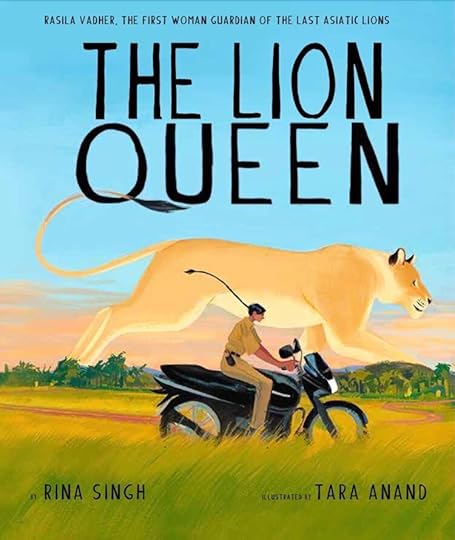 Welcome to Cantastic Authorpalooza, featuring posts by and about great Canadian children’s book creators! Today’s guest:
Rina Singh
. Take it away, Rina!
Welcome to Cantastic Authorpalooza, featuring posts by and about great Canadian children’s book creators! Today’s guest:
Rina Singh
. Take it away, Rina!
The Lion Queen was inspired by the true story of Rasila Vadher, the first woman guardian of the last Asiatic Lions of India’s Gir Forest. The book is gorgeously illustrated by Tara Anand and published by Cameron Kids.
There are two stories intertwined in the book–– the story of lions and of the lion queen.
Gir Forest in the state of Gujarat is the only place in the world where Asiatic lions are found. Everywhere else in Asia, they were hunted into extinction.
There came a time in India too when only a dozen lions were left. However, the 2020 census was very encouraging, showing that there were 674 lions in the Gir forest. It took about a hundred years, but it has now become one of the world’s most successful wildlife conservation stories.
In 2007, in a historic move, Gir forest hired women for the very first time.
Rasila was the first one.
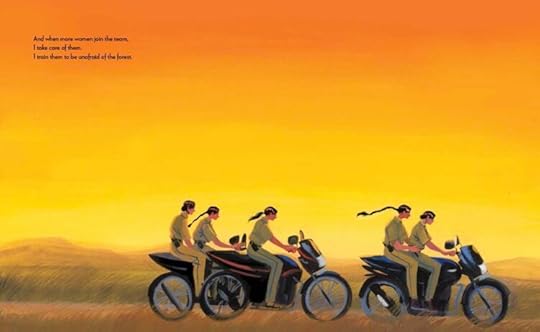 I saw a documentary where I saw her darting fierce lions with tranquilizers, wrestling with pythons, saving leopards, arresting poachers, and nursing abandoned cubs on quiet days.
I saw a documentary where I saw her darting fierce lions with tranquilizers, wrestling with pythons, saving leopards, arresting poachers, and nursing abandoned cubs on quiet days.
I was so fascinated that I knew I had to write her story.
Crafting an exciting story that seamlessly blends women’s power and protecting wildlife was a bit of a challenge. I wanted to create a story that kids would love and learn from.
During my research, I got carried away with the gripping story of the Asiatic lions. So, I thought the story would be better off as a graphic novel. I wrote the story in a graphic novel format, and eventually, it was acquired as a picture book. However, I made sure the story of Asiatic lions was still in there, even though I had to leave out many details.
It was important for me to make Rasila, the main character, feel real and relatable. I wanted to understand her feelings and what made her so brave. I even talked to her on the phone! She shared details that I would have never found otherwise. I also watched movies and documentaries about lions to learn more.
I used the lion’s roar as a metaphor for Rasila’s courage.
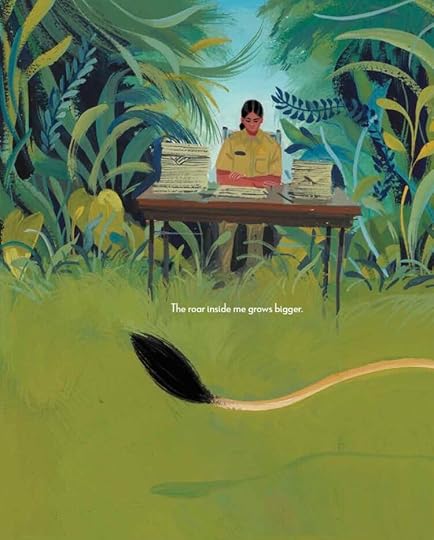
Both the lions and women are symbols of beauty and strength, yet they are surprisingly fragile against the forces of man. Despite the odds, they not only survived but thrived.
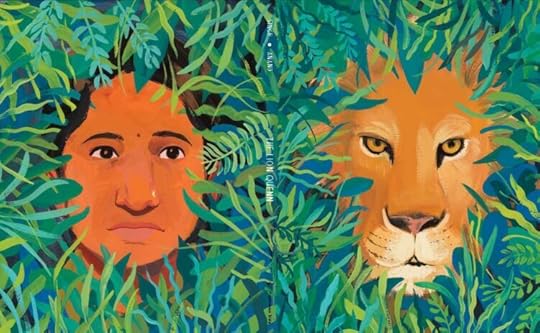
I hope my book will help readers discover their own roar and contribute to creating a compassionate world that resounds with the roar of the majestic lions.
The Lion Queen is on New York Public Library’s Best Books of 2023!
Kirkus called it ––A stirring story of persistence and courage.
Here’s a fun fact: Baby lions practise their roar from the time they are born—and by the time they are one year old, the roar is fully developed and is as loud as thunder.
Roaarr!
To learn more about Rina Singh and her work, visit her website.
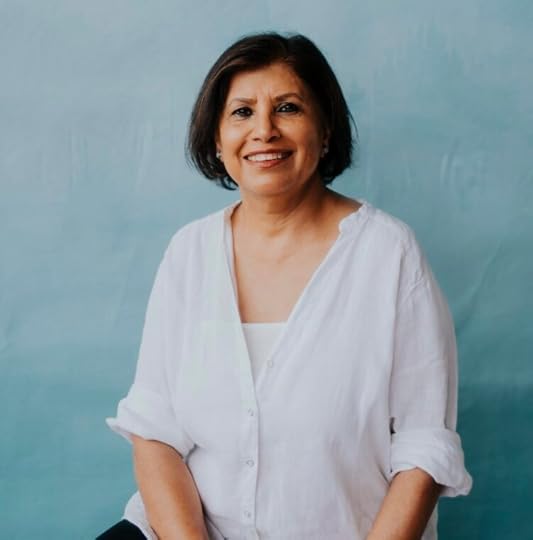
December 1, 2023
Happy Antarctica Day: Fun Facts and Recommended Reading
Happy Antarctica Day!
I’ll be honest: I have no idea how it’s even December already, so today’s post celebrating Antarctica is a little less polished and a little more… random. We’ll start with a couple fun facts leftover from Polar research, and end with a few gift-giving suggestions for the best of all winter holidays, Iceland’s Jolabokaflod, or Christmas Book Flood.
Fun FactsThe earliest written record of penguins is from 1499, in an account of Vasco da Gama’s voyage to India. He described “birds as large as ganders and with a cry resembling the braying of asses, which could not fly.” Historians are pretty sure he was talking about African penguins, also called “jackass penguins” for the similarity between their call and a donkey’s!
Europeans discovered Antarctica (and its penguins) in the 18th century. But they weren’t the first to arrive. There are Polynesian legends describing “the frozen ocean,” which suggests that Pacific Islanders had already been there.
Antarctica’s Mount Erebus is the southernmost active volcano in the world.
The continent has been covered in ice for about 15 million years. But it wasn’t always! There be dinosaur bones down there.
Gift-GivingFor the junior book lover on your list, might I suggest my very own Polar: Wildlife at the Ends of the Earth? It is full of incredible facts about the animals of Antarctica (and the Arctic). And the illustrations, by Byron Eggenschwiler, are absolutely stunning. You can buy Polar for the art alone and feel like you got your money’s worth.
Buying for grown-ups? How about the memoir of an Antarctic scientist? Check out My Penguin Year, by Lindsay McCrae.
Want something more historical? Try Madness at the End of the Earth: The Belgica’s Journey Into the Dark Antarctic Night. Bonus fun fact: Belgica is the genus name of Antarctica’s largest true land animal – an insect called the Antarctic midge (Belgica antarctica).
And for the hard-core science fan on your list: Dinosaurs of Darkness, Second Edition, by Thomas H. Rich and Patricia Vickers-Rich. It’s about the discovery of dinosaurs in the Australia of 120 to 100 million years ago – a period when Australia was part of Antarctica!
Do you have a favourite book or fact about Antarctica? Share in the comments!
November 24, 2023
Susan Currie: Perseverance and Iz the Apocalypse
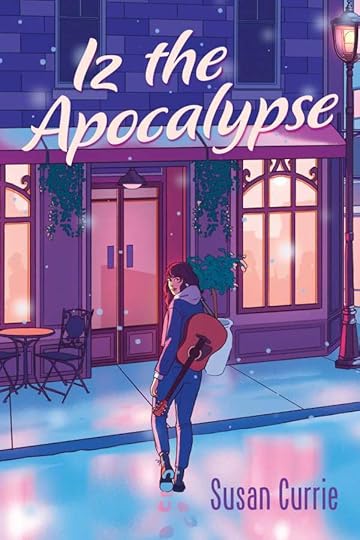 Welcome to Cantastic Authorpalooza, featuring posts by and about great Canadian children’s book creators! Today’s guest:
Susan Currie
. Take it away, Susan!
Welcome to Cantastic Authorpalooza, featuring posts by and about great Canadian children’s book creators! Today’s guest:
Susan Currie
. Take it away, Susan!
Iz the Apocalypse took me seven years to write. I’ve honestly lost count of how many versions there were. Characters and storylines came and went as I fought to figure out exactly how to tell Iz’s story. My husband told me I needed an exit strategy from this book!
I don’t know exactly why I kept struggling with the manuscript, except that there was something about my main character, Iz, that wouldn’t let me go. She’s the definition of resilient—a highly gifted 14-year-old foster kid who desperately wants to attend The Métier School, a prestigious international high school for music. When faced with systemic barriers to her goal, she resorts to creative manipulation of multiple bureaucracies. She fights for the opportunity to find her people and her voice. In the process, she catastrophically overturns the world around her, like an apocalypse that obliterates old things but leaves room in the wreckage for the possibility of something new.
Probably my own experiences as a frustrated teacher with a front seat to the challenges of children in foster care, were part of what drove me to keep going. I’ve worked with kids who were moved around so much that their report cards were mostly incomplete or else peppered with mediocre marks. Their arrival in a new school was often preceded by case conferences intended to manage anticipated issues. Their potential, even giftedness, ran the risk of being unnoticed because divergent words and actions could be so easily misunderstood as a problem to be fixed. It bothered me intensely that talented students were being systemically barred from the opportunity to go on to higher education because of conditions simply related to being in foster care.
Another factor that made me unable to let this story go was my own history as an adoptee who spent a short time in the foster care system. Iz is very close to me, as we share the sentiment that we don’t quite exist in three dimensions, as well as the resentful feeling of being “managed” within the tangled bureaucracy of care. This management has continued into adulthood. For example, my personal records were sealed until I was well into middle age; and when I finally received a copy of them, I discovered that much of my own information had been blacked out. Furthermore, when I learned that I had a birth sibling who had also been placed in care I was firmly told that the system would not be able to provide me with any information about him unless there was a medical emergency he needed to know about. After some creativity worthy of Iz’s best moves, my brother Rob and I are now happily very much in each other’s lives.
Another reason why I couldn’t walk away from Iz is that I was entirely obsessed with embedding a secret second story in hers, kind of like a crossword puzzle. As I kid, I was deeply influenced by Alan Garner’s The Owl Service, in which the myth of Blodeuwedd simmers magically and threateningly just under the surface of the story of teenagers in the present. Iz’s journey to find herself is entangled with Schubert’s song cycle Winterreise (“The Winter Journey”). Schubert’s work is wound into the plot, into characters, into dialogue and eventually into Iz’s own explosion of creativity. Basically, I spent seven years deep in a rabbit hole of symbol and metaphor, in which hardly a word of the manuscript doesn’t have some kind of link to an alternative meaning. If you’re familiar with Winterreise then you will see it everywhere, in Iz’s wandering, in doubles and doppelgängers, in Hurdy Gurdy men, in wedding planning, in the seeming madness and meaninglessness of the world of Dominion Children’s Care. If you’re not familiar with Winterreise, though, the story of Iz still works just fine as a story of a kid engaging in criminal activities in order to achieve her dream!
So, here we are, with Iz the Apocalypse finally in the world, after I’d truly despaired of it ever finding a publishing home. It’s a nominee for the 2024 White Pine Award in the Forest of Reading, as well as a Junior Library Guild Gold Standard Book. In addition, it’s just been named a Fall 2024 YA book in “Top Grade: CanLit for the Classroom.” CBC listed it in “25 YA books to read in Fall 2023.” Quill and Quire included it in their “2023 Fall Preview of Young Adult and Nonfiction.” And I’m excited to reveal that I’ve just signed a two-book deal with Common Deer Press to turn Iz’s story into a trilogy.
Ultimately, then, I guess the moral of this blog post is that one shouldn’t give up, even when a way forward seems murky and unclear. I found my exit strategy by just doggedly stumping alongside my ferocious foster kid until we came out the other side.
November 10, 2023
Leslie Gentile: Novel Writing with Music – the Unexpected Connection
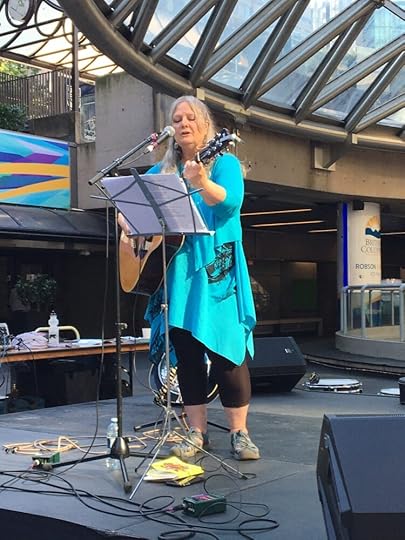 Welcome to Cantastic Authorpalooza, featuring posts by and about great Canadian children’s book creators! Today’s guest:
Leslie Gentle
. Take it away, Leslie!
Welcome to Cantastic Authorpalooza, featuring posts by and about great Canadian children’s book creators! Today’s guest:
Leslie Gentle
. Take it away, Leslie!
It started with a boring writers’ bio. When my first book, a middle grade novel called Elvis, Me, and the Lemonade Stand Summer, was published (Cormorant/Dancing Cat Books 2021), my writing accomplishments were pretty slim, so in my bio I included the fact that I was also a song writer. When I began to get asked to do readings for kids, teachers and librarians would ask, “Hey, can you do some songs with your readings?”
Which I was happy to do. But I found it hard to find songs to fit the readings (and I wasn’t about to embark on a new career as an Elvis impersonator!), so I wrote some songs to go with my book. As I did, I discovered something fascinating. When I began to write the sequel, called Elvis, Me, and the Postcard Winter (to be released in 2024), I revisited some of the original characters. I discovered that writing while playing these songs gave me a deeper insight into my characters, and I know that it helped make the story stronger.
For example, the main character’s mother, Clarice, is an alcoholic, single parent always on the lookout for the next Mr. Wrong. At the end of the first book (Spoiler alert!) she abandons her daughter, Truly. In the sequel, Clarice returns, and I explore redemption, second chances, and an attempt to heal old wounds. Writing the song ‘I Just Want to Dance’, which is Clarice’s lament, I wanted to explore empathy with the listener, to hopefully explain but not excuse the roots of her behaviour. But I found that this song in particular had an unexpected benefit —it gave me a much richer understanding of the character’s background, and why she ended up where she is. Whenever I hit a roadblock in my writing, I would pull out my guitar, and play Clarice’s song to get me back on track. This meant that in my writing, I delved deeper into Clarice’s past so that the reader can clearly see why she ended up making the choices that she made in her life, and why she ended up feeling trapped:
I used to be the one they all envied,
I used to be the one they idolized,
And now my future looks so empty,
It feels like life has passed me by
I always felt like I was looking in a window,
Standing on the outside looking in
I never knew real love or approval,
I never felt good in my own skin.
I just want to dance like I used to do,
It was the only time that I could breathe,
I just want to dance just like I used to do.
And one more time I could feel free.
I’m stuck in a prison of my own making,
I’m trapped in a life that I don’t like.
It’s like a bad dream and I’m not waking,
Stuck in a long and endless night.
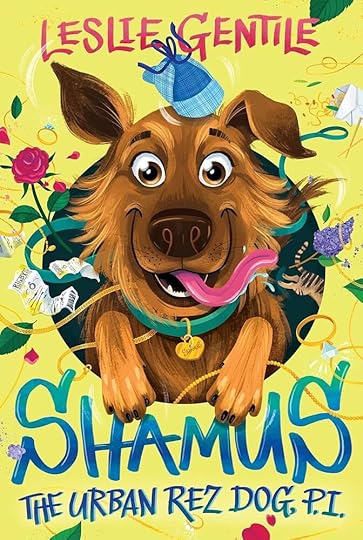 My second book, Shamus the Urban Rez Dog, P.I., is a completely different animal — the story is told by Shamus the happy-go-lucky dog, as he helps his kids solve a mystery. This time, I wrote the songs as I wrote the book and found once again that it helped me dig deeper into my characters and as well as the storyline.
My second book, Shamus the Urban Rez Dog, P.I., is a completely different animal — the story is told by Shamus the happy-go-lucky dog, as he helps his kids solve a mystery. This time, I wrote the songs as I wrote the book and found once again that it helped me dig deeper into my characters and as well as the storyline.
The song ‘Free Wheelin, Fun Loving Urban Rez Dog On the Loose” helped me capture the sheer joy Shamus feels as he chases Mr. Tibbles the cat, with lines like:
I’ve got the wind in my fur and my paws are a blur,
I’ve got a cat in my sights, it’s one of life’s delights,
I’m hot on the tail of that annoying tabby,
Let me tell you, he doesn’t look happy.
Cuz I’m a free wheelin, fun lovin, urban rez dog on the loose.
Later, when Shamus finds himself in trouble at the townhouse complex where the family lives, and faces the unthinkable fate of being sent away, the blues song ‘Bad Dawg Blues’ helped me capture his feelings of anguish and grief:
You can’t stop a dawg from scratching at a flea,
You can’t stop the buzzing of a bumbling bumble bee,
You can’t stop a birdy from sleeping in his nest,
And you can’t stop a dawg from doin what he does best,
I’m just a bad dawg, with the bad dawg blues,
Just a bad dawg, who was born to lose.
So, while writing songs to accompany my middle grade books began with an innocent request to pair music with my readings, it’s now become an integral part of my writing strategy. When I’m stuck on a plot point, I just pick up my guitar and sing!
As part of a nomadic navy family, Leslie Gentile grew up singing and telling stories in the back seat of the car with her siblings, so it was only natural that she became a musician and author.
Her debut middle-grade novel Elvis, Me and The Lemonade Stand Summer won the Victoria Children’s Book Award, the Jean Little First-Novel Award, and was shortlisted for BC’s Red Cedar Award among several other awards. Her second novel, Shamus, The Urban Rez Dog, P.I. was released in September 2023.
Leslie has written songs to go with her readings and performs them across Canada and places as far away as Hong Kong. Leslie is of Salish, Tuscarora and Scottish heritage and lives on the traditional territory of the W̱SÁNEĆ people.
November 8, 2023
All-Canadian Updates for I Read Canadian Day
Happy I Read Canadian Day, everybody! If you’re not familiar, today is the day we celebrate Canadian stories by reading a Canadian book for 15 minutes. All forms of reading count, and you certainly don’t have to stop after 15 minutes. Goodness knows I never do!
This IRCD, I’ll be celebrating with Weird Rules to Follow by Kim Spencer. Kim’s book has won and been nominated for most of the major literary awards in Canada, and I can’t wait to check it out.
On to other news!
 Mr. Peanut’s Garden Report
Mr. Peanut’s Garden ReportRemember Mr. Peanut, our intrepid chipmunk gardener? Well. Tech Support and I spent most of September in Newfoundland. A few days after we got home, we discovered an absolutely massive tomato plant in our flower garden. This was a surprise for two reasons:
The tomato plant had gone from seed to sapling in just three weeks. In September.Neither Tech Support nor I had planted vegetables in the flower garden.As of this morning, Mr. Peanut’s tomato plant has actual tomatoes on it. At this point, it seems unlikely they will ripen before the frost comes, but maybe the chipmunk knows something we don’t…
Free Public Reading for North/West PassagesI’ll be one of the featured readers for the North/West Passages reading series on November 28. Other writers at the event include Leslie Greentree, Lexi Angelo, Meghan J. Ward, and kid lit super star (and author of books about stars) Joan Marie Galat.
It’s a free, virtual event – stay tuned for registration info!
Polar is a Eureka! Nonfiction Award Honor BookHuge thanks to the California Reading Association for naming Polar: Wildlife at the Ends of the Earth a 2023 Eureka! Awards Honor Book!! There’s some incredible nonfiction on the list, so be sure to check out all of this year’s winners and honor books. Especially if you’re already working on your holiday gift lists.
Speaking of which…
Polar Makes the Indigo Christmas Gift Guide!I am beyond thrilled to share that Polar is also featured in the IndigoKids Christmas Gift Guide! This would be incredible news for any author, but it’s particularly special for me.
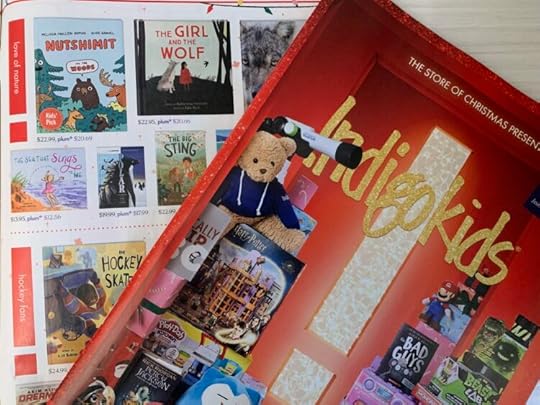 That’s because my first job out of graduate school was children’s bookseller at Chapters in St. Albert, Alberta. Not because of the dismal academic job market (though it is, indeed, dismal), but simply because I was exhausted, and my long-stifled inner writer just wanted to be near the books all day.
That’s because my first job out of graduate school was children’s bookseller at Chapters in St. Albert, Alberta. Not because of the dismal academic job market (though it is, indeed, dismal), but simply because I was exhausted, and my long-stifled inner writer just wanted to be near the books all day.
That particular Chapters was a lot like your favourite indie bookstore – staffed by people who were passionate about finding the perfect book for every reader. Working there helped me understand the retail end of the publishing industry, and gave me eye-opening insights into the way people shop for and select books – for themselves, and for young readers. In short, a fantastic experience for any budding author… even if it did take me ten more years to finish reading all the books I bought with my staff discount!
So yes – an Indigo seal of approval on a book that I actually wrote? That’s the best holiday gift I could have received.
Are you celebrating I Read Canadian Day? Already planning ahead to the holidays? I’d love to hear your updates, too.
October 20, 2023
Valerie Sherrard: More Than Words – Navigating the Complex World of Communication
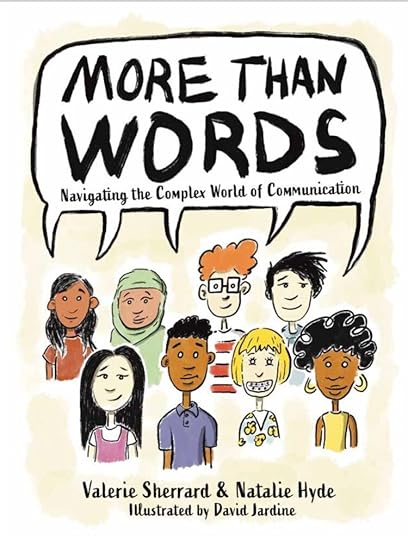 Welcome to Cantastic Authorpalooza, featuring posts by and about great Canadian children’s book creators! Today’s guest:
Valerie Sherrard
. Take it away, Valerie!
Welcome to Cantastic Authorpalooza, featuring posts by and about great Canadian children’s book creators! Today’s guest:
Valerie Sherrard
. Take it away, Valerie!
I’ve been making things up since I was a young child, although my talents went generally unappreciated back then. As a small maker-up-of-things, I felt insulted when playmates refused to believe my stories. So what if they were obviously untrue? It was beyond me why that would make any difference.
Fast forward to today and I can truthfully say that the love of building characters and creating stories has never left me. When I got serious about writing, fiction was the natural place for my words to find a home. At long last I could make things up and reap amazing benefits. (Such as heaps of cash, because that’s the wild kind of imagination I have!)
And so, for more than 20 years, I have happily composed stories for young people, from picture books up to young adult novels.
Until …
You can’t even imagine how unprepared all of this made me for the day when an idea for a non-fiction book on communication came to me. The concept took a few forms over the next I’m-not-sure-how-many years and during that time I put together several samples and outlines and made some very feeble pitches. (I didn’t know they were feeble at the time, obviously.)
Eventually, the sad realization came: I had no clue what I was doing. Which was frustrating, considering how strongly I believed in the idea. On the other hand, I knew people who were experts on non-fiction. It was time to find a partner.
What a lucky thing it was, the day I reached out to Natalie Hyde. Natalie has more than 100 books to her credit, the bulk of them being non-fiction for young people. (Her fiction is fantastic too, by the way.) I ran the idea by her, she liked it, and a very happy partnership began.
We worked on an outline and sample. And we reached out to artist David Jardine. He liked the project, and found room for it in his busy schedule.
Together with some sketch samples from David, we sent our pitch to DCB Young Readers Publisher Barry Jowett and in what may have only seemed like an agonizingly long time we had his answer. It was YES. (This would be a much duller story if he’d turned it down.)
And now, it’s here! More than Words: Navigating the Complex World of Communication.
Here’s why my co-creators and I think you should read this if you’re a young person, or even just a person:
Maybe you’ve never thought about it, but you are constantly communicating, and with more than just words. Body language, hand gestures, facial expressions — they all have a lot to say. Are you aware of the silent signals you may be sending? How do you read verbal and nonverbal cues from other people?
Through this illustrated book, you will learn how to communicate effectively —virtually and in person —with more confidence and fewer misunderstandings. You’ll learn about active listening, speaking skills, empathy, conflict resolution, critical thinking, and more!
Then you’ll put your newfound knowledge into practice through individual exercises and group activities that will help you master your communication superpowers!
October 14, 2023
The Marathon Migrations of Arctic Terns (Revisited)
Hold on, you’re saying to yourself, I think I’ve read this post before… You’re not wrong! There are TWO World Migratory Bird Days every year, because – surprise! – migration is a round trip. At least, that’s how we usually define it. There are actually three types of migration, only one of which is round-trip, and if you’re interested, I offer a STEM presentation on this topic – contact me to learn more!
But back to the birds. 
In May, arctic terns were just starting to arrive in their Arctic breeding grounds. Right now, they are headed for Antarctica. If you missed reading about why terns are awesome in the spring, now’s your chance to catch up on these cool birds and their incredible adaptation.
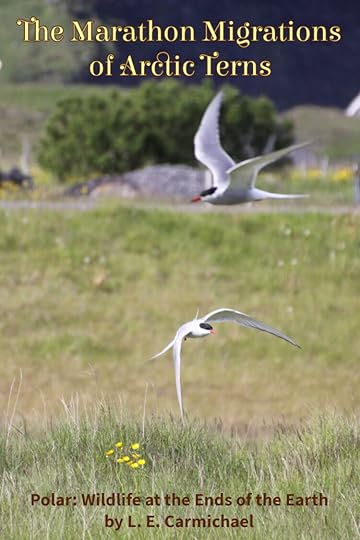 In 2014, Tech Support and I were lucky enough to visit Iceland during June, when migratory birds were nesting. We saw puffins and petrels and gulls and guillemots packed onto jagged cliff edges. But what I remember most is walking through the field back to the tour bus and getting dive-bombed by arctic terns who’d built their nests in the long grass flanking the path.
In 2014, Tech Support and I were lucky enough to visit Iceland during June, when migratory birds were nesting. We saw puffins and petrels and gulls and guillemots packed onto jagged cliff edges. But what I remember most is walking through the field back to the tour bus and getting dive-bombed by arctic terns who’d built their nests in the long grass flanking the path.
Today is World Migratory Bird Day, making it the perfect day to talk about terns – the champion migrators of the biological world. Adult terns weigh about 100 g, and every year, they make round-trip journeys of up to 50,000 km. 50,000 km, at speeds of up to 670 km per day.
The “legs” of a tern’s journey are typically different lengths, but for the ease of math, let’s assume they are the same. That’s 25,000 km one-way. The record one-way migration for an adult male humpback whale is 18,840 km.
Terns can live more than 30 years, meaning one tern might travel more than 2.4 million kilometers during its lifetime. That’s the equivalent of about three trips to the Moon and back. I’m exhausted just thinking about it!
What could possibly motivate such teensy birds to make such epic journeys? Well, terns nest in the Arctic, during summer in the Northern Hemisphere: they arrive at their breeding grounds in May.
Terns molt – shedding old feathers and growing new ones – in Antarctica, during summer in the Southern Hemisphere. In other words, terns never experience winter: they are always in the right place, at the right time, to take advantage of long summer days and mild temperatures.
Migration timing also seems to be linked to periods of peak ocean productivity. Scientists tracking terns with tiny GPS loggers have shown that terns arrive in each staging location right when the most fish and krill are available to eat – important, because those rich food sources give them the energy they need to keep going. When they reach Antarctica, they also tend to hang out on icebergs or the edge of the pack ice. This gives them solid surfaces to rest on, but really easy access to open water for fishing in.
For terns, the benefits of their extreme migrations seem clear. But migration is not without its risks – for terns and many other species. All that travel takes a ton of energy. Birds can get lost or blown off course in bad weather. They have to pass through areas of unsuitable habitat – places without food, or places inhabited with unfamiliar predators. Birds that orient using natural light cues often get confused by the lights of human cities.
That’s why many migratory bird species are protected under the Migratory Birds Convention Act. You can explore the list of species protected in Canada at this link. Arctic terns are included!
For some ways you can help protect birds this World Migratory Bird Day, check out these lists:
Five Ways You Can Make a Difference for Migratory Birds
Six Ways to Help Migratory Birds
10 Ways to Help Migratory Birds
Arctic terns are one of several migratory birds that appear in Polar: Wildlife at the Ends of the Earth. The book is out now – grab your copy at your favourite indie bookseller, or one of the online retailers below:
I’m now booking Polar-themed school and library visits! Contact me to inquire about dates and rates.
Calling all educators! I’m presenting at the North American Association for Environmental Education conference later this month, with fellow children’s science author Rochelle Strauss. The event is virtual, registration is open, and we’d love to see you there!
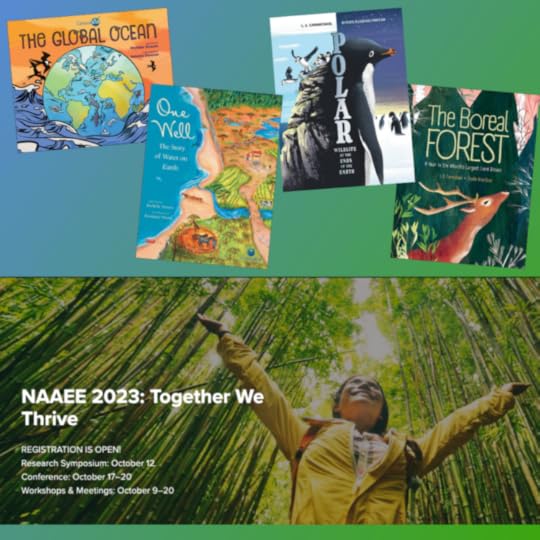
October 6, 2023
Caroline Fernandez: Lifting Up Women in STEM
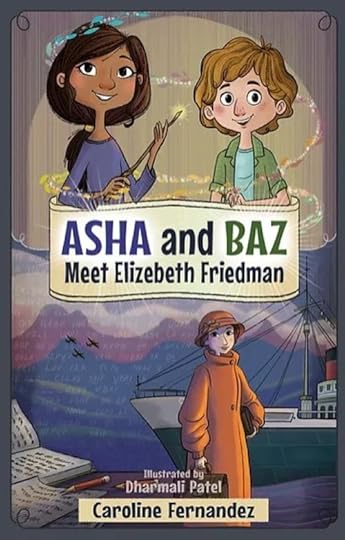 Welcome to Cantastic Authorpalooza, featuring posts by and about great Canadian children’s book creators! Today’s guest:
Caroline Fernandez
. Take it away, Caroline!
Welcome to Cantastic Authorpalooza, featuring posts by and about great Canadian children’s book creators! Today’s guest:
Caroline Fernandez
. Take it away, Caroline!
There aren’t a lot of women in STEM (Science, Technology, Engineering, Math) who grace the pages of history books. Perhaps it is because of lack of education or opportunity. Perhaps it’s because of gender roles. Perhaps it’s because the history books were usually written by men.
When I outlined my illustrated chapter book series Asha and Baz, the main theme was that the two characters would travel back in time and meet women in STEM. Women who overcame challenges to make amazing discoveries. And through my research, I realized women in STEM was a great category of female history-makers.
There are stacks of books about men in STEM: Isaac Newton, Albert Einstein, Alexander Graham Bell, Alan Turing, etc.
But can you name a historical woman in STEM?
Women in history stories are relevant to today’s readers. These trailblazers had to overcome the challenges of their gender, education, social class, and opportunity. They stepped beyond what was expected of them, by the outside world, to what they dreamed for themselves. They weren’t in it for the fame (see above about not being in the history books) or the money (there are no royalties for their findings). They were simply dedicated to their own innovation.
All readers benefit from learning about famous women in STEM. Readers can learn about inspiration, motivation, and discovery through historical women. These women were often required to be resourceful. They often had to side-hustle their work in STEM due to family obligations.
For example:
Mary Sherman Morgan. She was an American rocket scientist. She created a rocket fuel which boosted the United States of America into the space race. Unfortunately, she did not get credit for her work in her lifetime.
Hedy Lamarr. She was a well-known actress but little known as an inventor. She and George Anthiel invented frequency hopping (she has a patent on it and everything!). Frequency hopping is the basis of Bluetooth and WiFi today.
Elizabeth Friedman. She was an American codebreaker. Her job was breaking secret messages for various U.S. government organizations. During World War II she broke a message which saved the lives of 6,000 men aboard the vessel the Queen Mary.
Katia Krafft: She was a volcanologist. She studied erupting volcanoes and compiled research to help create early warning systems to save lives of people living near active volcanoes.
Gladys West. She is an American mathematician. While working for the Navy, she did the math to help create a little thing known as GPS. GPS is used worldwide for directions and locations.
Asha and Baz Meet Elizebeth Friedman launched September 2023. In the third book in the Asha and Baz series, readers learn about secret codes and how to break them from World War II codebreaker Elizebeth Friedman! A secret code and a mysterious prize up for grabs at school prompts Asha and Baz to once more use their magic stick to travel to the past. This time they land in 1942, where they meet Elizebeth Friedman, a codebreaker working with the US Navy. She’s the perfect person to help the kids with their codebreaking challenge, but she’s hard at work decoding secret messages from Nazi spies! With a navy officer pressuring Elizebeth to work quickly and the Allied war efforts at risk, the kids could be in for more than they expected in Asha and Baz Meet Elizebeth Friedman!
Other books in this illustrated chapter book series:

